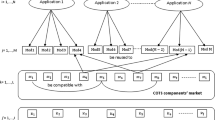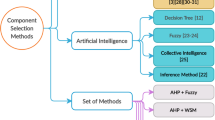Abstract
In this paper, we present a multiobjective credibilistic model for commercial off-the-shelf (COTS) products selection in a modular software system under a fuzzy environment. To treat imprecise parameters, we use a credibility-based approach that combines the expected value and chance-constrained programming techniques. The model simultaneously minimizes the total cost, size, and execution time of the modular software system subject to many realistic constraints including system reliability, delivery time, and compatibility issues among the available COTS products. We use a two-phase interactive approach as the solution methodology. An empirical study is included to demonstrate the applicability of the proposed model and the solution approach in real-world applications of COTS selection. Further, a thorough performance analysis and comparison is done to claim the superiority of the proposed methodology over the existing fuzzy programming approaches used for COTS products selection problem.





Similar content being viewed by others
References
Abd El-Wahed WF, Lee SM (2006) Interactive fuzzy goal programming for multiobjective transportation problems. Omega 34:158–166
Bellman R, Zadeh LA (1970) Decision making in a fuzzy environment. Manag Sci 17:141–164
Berman O, Ashrafi N (1993) Optimization models for reliability of modular software systems. IEEE Trans Software Eng 19:1119–1123
Chi DH, Lin HH, Kuo W (1989) Software reliability and redundancy optimization. In: Proceedings of the annual reliability and maintainability symposium. IEEE, Atlanta, pp 41–45
Gupta P, Mehlawat MK, Mittal G, Verma S (2009) A hybrid approach for selecting optimal COTS products. Lect Notes Comput Sci 5592:949–962
Gupta P, Verma S, Mehlawat MK (2011) A member ship function approach for cost-reliability trade-off of COTS selection in fuzzy environment. Int J Reliab Qual Saf Eng 18:573–595
Gupta P, Mehlawat MK, Verma S (2012) COTS selection using fuzzy interactive approach. Optim Lett 6:273–289
Gupta P, Pham H, Mehlawat MK, Verma S (2013) A fuzzy optimization framework for COTS products selection of modular software systems. Int J Fuzzy Syst 15:91–109
Jha PC, Kapur PK, Bali S, Kumar UD (2010) Optimal component selection of COTS based software system under consensus recovery block scheme incorporating execution time. Int J Reliab Qual Saf Eng 17:209–222
Jha PC, Bali S, Kumar UD (2011) A fuzzy approach for optimal selection of COTS components for modular software system under consensus recovery block scheme incorporating execution time. Turkish J Fuzzy Syst 2:45–63
Jung HW, Choi B (1999) Optimization models for quality and cost of modular software systems. Eur J Oper Res 112:613–619
Kwong CK, Mu LF, Tang JF, Luo XG (2010) Optimization of software components selection for component-based software system development. Comput Ind Eng 58:618–624
Lai YJ, Hwang CL (1994) Fuzzy multiple objective decision making-methods and applications. Lect Notes Econ Math Syst, vol 404. Springer, Berlin
Li XQ, Zhang B, Li H (2006) Computing efficient solutions to fuzzy multiple objective linear programming problems. Fuzzy Set Syst 157:1328–1332
Liu B, Liu YK (2002) Expected value of fuzzy variable and fuzzy expected value models. IEEE Trans Fuzzy Syst 10:445–450
Liu B (2004) Uncertainty theory: an introduction to its axiomatic foundations. Studies in Fuzziness and Soft Computing, vol 154. Springer, Heidelberg
Mehlawat MK (2014) A fuzzy approach to multiobjective COTS products selection of modular software systems using exponential membership functions. Int J Reliab Qual Saf Eng 21:1450005. 17 pages
Neubauer T, Stummer C (2007) Interactive decision support for multiobjective COTS selection. In: Proceedings of the 40th annual Hawaii international conference on system sciences. IEEE, Waikoloa. HI 283b
Rao C, Peng J (2009) Fuzzy group decision making model based on credibility theory and gray relative degree. Int J Inform Tech Decis Making 8:515–527
Schrage L (2006) Optimization modeling with LINGO, 6th edn. LINDO Systems Inc., Illinois
Shen X, Chen Y, Xing L (2006) Fuzzy optimization models for quality and cost of software systems based on COTS. In: Proceedings of the sixth international symposium on operations research and its applications. Xinjiang ORSC & APORC 312–318
Tang JF, Mu LF, Kwong CK, Luo XG (2011) An optimization model for software component selection under multiple applications development. Eur J Oper Res 212:301–311
Tiwari RN, Dharmar S, Rao JR (1986) Priority structure in fuzzy goal programming. Fuzzy Set Syst 19:251–259
Torabi SA, Hassini E (2008) An interactive possibilistic programming approach for multiple objective supply chain master planning. Fuzzy Set Syst 159:193–214
Trivedi KS (2001) Probability and statistics with reliability, queuing, and computer science applications, 2nd edn. Wiley, New York
Zachariah B, Rattihalli RN (2007) A multicriteria optimization model for quality of modular software systems. Asia Pac J Oper Res 24:797–811
Zadeh LA (1965) Fuzzy sets. Inform Contr 8:338– 353
Zadeh LA (1978) Fuzzy sets as a basis for a theory of possibility. Fuzzy Set Syst 1:3–28
Zahedi F, Ashrafi N (1991) Software reliability allocation based on structure, utility, price and cost. IEEE Trans Software Eng 17:345–356
Zhu H, Zhang J (2009) A credibility-based fuzzy programming model for APP problem. In: Proceedings of the international conference on artificial intelligence and computational intelligence, vol 1. Shanghai, pp 455–459
Acknowledgment
We are thankful to the Editor-in-Chief, associate editor, and the anonymous referees for their valuable comments and suggestions to improve presentation of the paper. Further, we also acknowledge the support through Research and Development Grant received from University of Delhi, Delhi, India.
Author information
Authors and Affiliations
Corresponding author
Rights and permissions
About this article
Cite this article
Mehlawat, M.K., Gupta, P. Multiobjective credibilistic model for COTS products selection of modular software systems under uncertainty. Appl Intell 42, 353–368 (2015). https://doi.org/10.1007/s10489-014-0602-5
Published:
Issue Date:
DOI: https://doi.org/10.1007/s10489-014-0602-5




